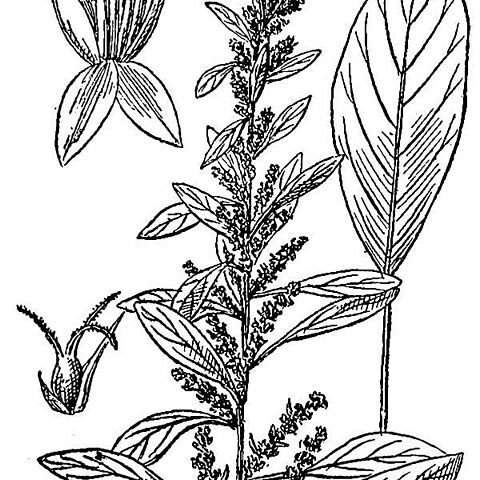Stems erect to sometimes ascending or rarely prostrate, branched, rarely simple, usually (0.5-)1-2(-3) m. Leaves: petiole 1/4-1/2 length of blade; blade ovate or obovate proximally, oblong or elliptic to narrowly lanceolate distally, 1.5-15 × 0.5-3 cm, base cuneate, margins entire, plane, apex obtuse or rounded to acute. Inflorescences terminal, linear spikes to panicles, occasionally interrupted-moniliform, remote, globose glomerules. Bracts: of pistillate flowers 1-2 mm; of staminate flowers with inconspicuous to prominent midrib, 1-2 mm, apex acuminate to short-subulate. Pistillate flowers: tepals absent or 1-2, often rudimentary, 1-3 mm; style branches ± erect; stigmas 3. Staminate flowers: tepals 5, inner tepals with prominent midribs excurrent as rigid spines or not, equal to unequal, 2-3 mm, apex obtuse to acute or acuminate or indistinctly mucronulate; stamens 5. Utricles dark brown to reddish brown, not ribbed, obovoid to subglobose, 1.5-2 mm, thin, almost smooth or irregularly rugose, indehiscent, irregularly dehiscent, or dehiscence regularly circumscissile. Seeds dark reddish brown to dark brown, 0.7-1 mm diam., shiny.
More
Dioecious; prostrate to erect, to 2 m; lvs and infls highly variable; bracts 1–1.5 mm, with slender, strongly excurrent midvein; male fls with 5 subequal sep 2.5–3 mm, the outer acuminate, the inner obtuse or emarginate, the midvein not excurrent; female fls usually without perianth, occasionally with 1 or 2 vestigial sep under 1 mm; fr 1.5–2 mm, indehiscent or bursting irregularly, smooth or roughened; style branches 3 or 4; seeds 0.8–1 mm, lenticular to obovoid, dark reddish-brown; 2n=32. Margins of fresh water; Vt. to N.D., s. to N.J., O., Tenn., La. and Kans. (A. ambigens; Acnida altissima; Acnida subnuda)
Wet areas, such as margins of rivers, ponds, marshes, lakes, and creeks, disturbed habitats, such as agricultural fields, roadsides, and railroads; at elevations up to 1,000 metres.


